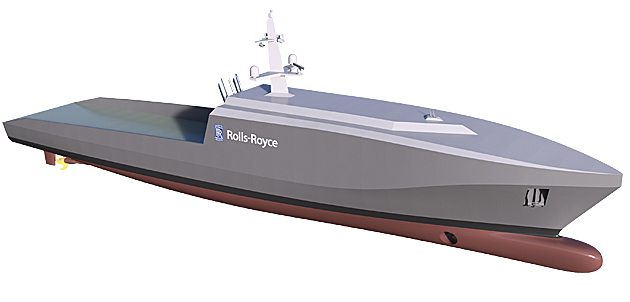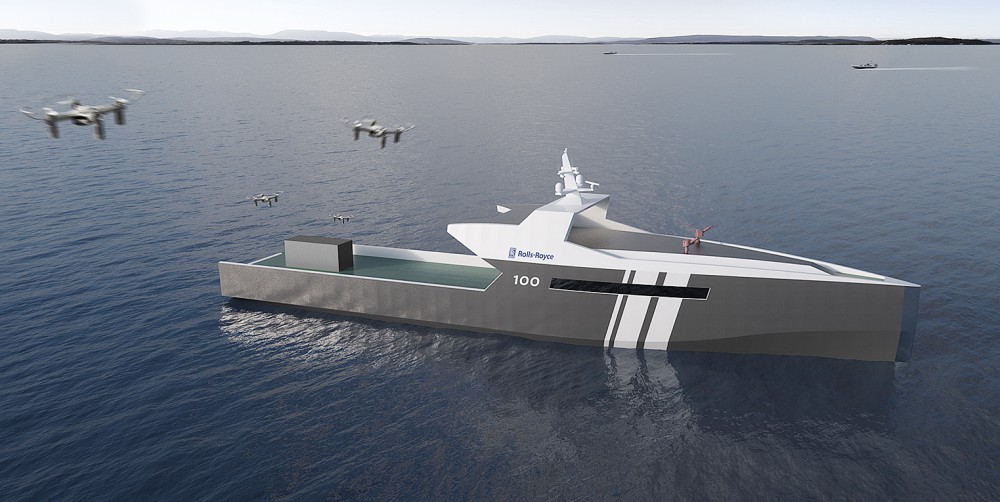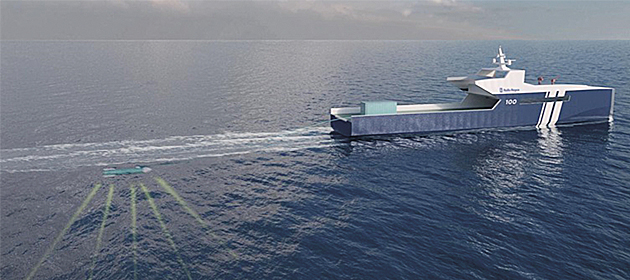Rolls-Royce has revealed plans for an autonomous, single role naval vessel. Capable of operating beyond the horizon for more than 100 days, with a range of 3,500 nautical miles, the 60m vessel will displace 700 tonnes and reach speeds above 25 knots.
It could be used for coastal patrol and surveillance, logistics support, or as part of a fleet deployment, protecting conventional manned warships. Benjamin Thorp, Rolls-Royce, General Manager Naval Electrics, Automation and Control, says:
“Rolls-Royce is seeing interest from major navies in autonomous, rather than remote-controlled, ships. Such ships offer navies a way to deliver increased operational capability, reduce the risk to crew and cut both operating and build costs.”
With ever-increasing pressure on defence budgets, navies see unmanned technology as a route to reducing the through-life costs associated with crew. The removal of manpower from ships radically changes the ship design. Many of the habitation systems and accommodation compartments are removed, bringing immediate cost savings and making the vessel smaller.
The absence of crew increases the need for very reliable power and propulsion systems. Rolls-Royce’s approach is to blend advanced Intelligent Asset Management and system redundancy in a cost-effective manner that avoids sacrificing the cost and volume savings achieved by removing the crew. A suite of autonomous support tools, developed by Rolls-Royce, such as Energy Management, Equipment Health Monitoring and predictive and remote maintenance, will ensure the availability of unmanned vessels.
“The operational profile of these platforms will be more complicated than commercial unmanned vessels,” says Thorp. “They will be expected to sail from A to B on patrol, avoiding ships and other navigational hazards. At some point between A and B, they will detect something, maybe a submarine, and the mission will change to tracking and surveillance. The power and propulsion system will then need to adopt an ultra-quiet mode to avoid detection.”
These added complexities differentiate naval autonomy from commercial and highlight the challenges. Many of the technologies needed to make autonomous ships a reality already exist. Rolls-Royce has created what it believes to be the world’s first Intelligent Awareness System, combining multiple sensors with Artificial Intelligence, to help commercial vessels operate more safely and efficiently. Significant analysis of potential cyber risks is also being undertaken to ensure end-to-end security.
 Building the future
Building the future
In terms of development, Thorp explains that Rolls-Royce is looking to build on its reputation for robust and reliable naval propulsion systems to produce the open architecture autonomous solution required for the power and propulsion system.
We will then seek partners to interface this with the naval navigation mission autonomous control systems. Over the next 10 years or so, the introduction of medium-sized unmanned platforms, particularly in leading navies, is expected and the concept of mixed manned and unmanned fleets will develop.
The autonomous platforms are likely to cover a range of single role missions, e.g. patrol & surveillance, mine detection or fleet screening, while the larger manned ships will cover the multi-role missions. By mixing the fleet composition in this way,navies will reap the operational and cost benefits offered by autonomous technology.
To be able to cover a number of single roles, Rolls-Royce is investigating the concepts of adaptability and modularity of the autonomous propulsion system to create a multi-mission platform. The vessel can then be used as a launch pad for Unmanned Aerial Vehicles (UAVs) in one mission and then re-roled as a submarine detection platform in the next.


